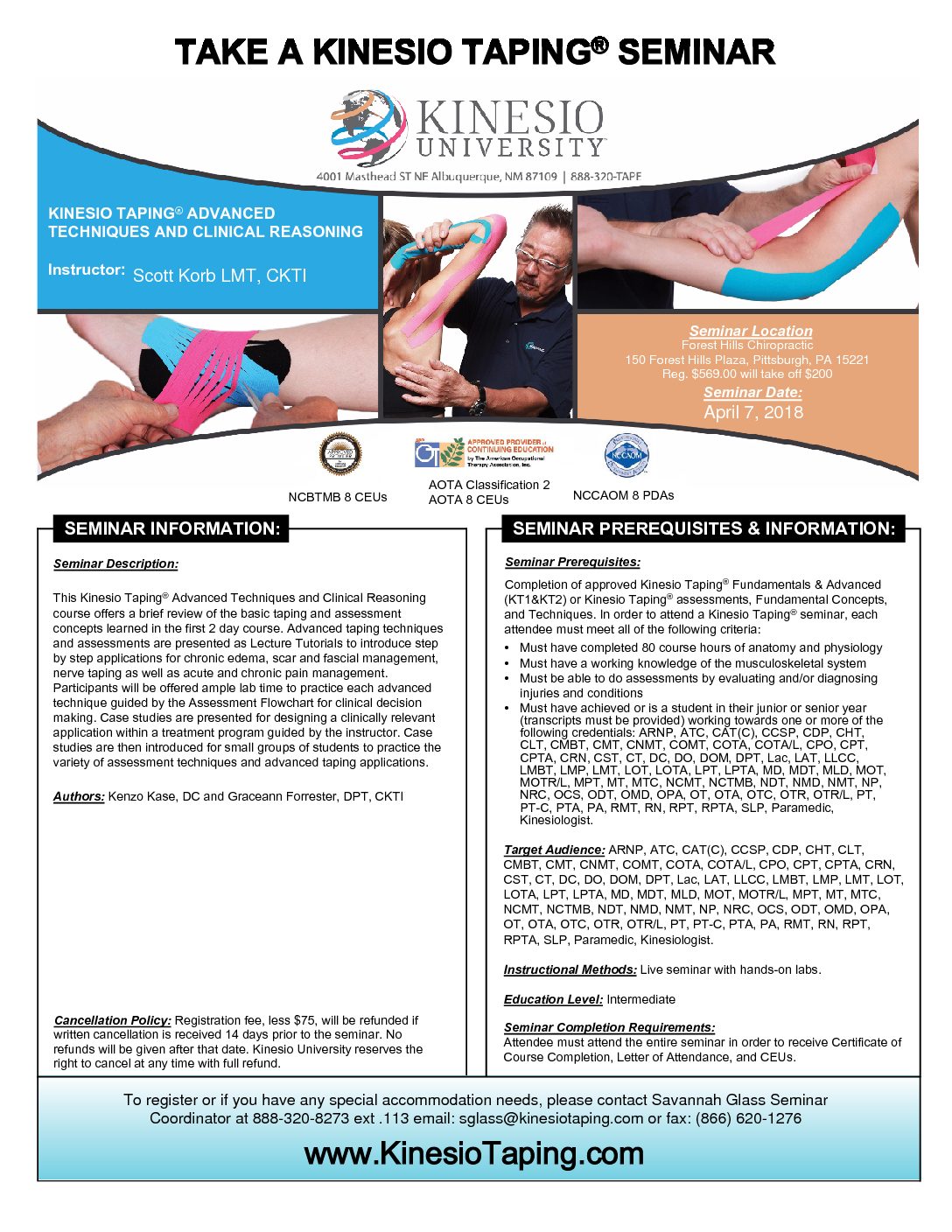Interested in hosting education seminars at your location? Contact us here or call 412-412-420-7183

- This event has passed.
Kinesio Seminar Day 3
April 7, 2018 @ 7:30 am - 5:30 pm
$279.00
Course Description:
This course offers a brief review of the basic taping and assessment concepts learned in the first 2 day course. Advanced taping techniques and assessments are presented as Lecture Tutorials to introduce step by step applications for chronic edema, scar and fascial management, nerve taping as well as acute and chronic pain management. Participants will be offered ample lab time to practice each advanced technique guided by the Assessment Flowchart for clinical decision making. Case studies are presented for designing a clinically relevant application within a treatment program guided by the instructor. Case studies are then introduced for small groups of students to practice the variety of assessment techniques and advanced taping applications.
Course Agenda:
| 7:30 am | Sign In |
| 8:00 | Instructor Introduction, Success Stories |
| 8:10 – 10:00 | Basic Application Guidelines and Assessments Review; Epidermis Correction Review and Introduction of Advanced Epidermis Webs Taping; Dermis Correction Reviewand Introduction of Advanced Dermis Jellyfish Taping |
| 10:00 | Break |
| 10:15 – 12:00 | Fascia Correction Review and Introduction of Advanced Fascia Taping – Ram’s Head, Manual Fascial Glide, and Nerve Tapings; Circulatory/Lymphatic Correction Review and Introduction of Advanced Basket Weave Application |
| 12:00 | Lunch |
| 1:00 – 3:20 pm | Space Correction Review and Introduction of Advanced Scar Management Applications; Muscle Corrections Review and Advanced Clinical Case Study – Chondromalacia Patella; Mechanical Correction Review and Advanced Clinical Case Study – Whiplash |
| 3:20 | Break |
| 3:35 – 4:05 | Function Correction Review and Introduction of Advanced Functional Application – Rotational Limb Corrections |
| 4:05 – 5:30 | Clinical Case Scenarios, Q&A; Evaluations/ Assessments, Conclusion |
Course Objectives:
- List specific symptoms of different types of tissue injury – nerve, muscle, epidermis, dermis, fascia and joint.
- Demonstrate application of advanced Epidermis Correction Technique – Web Layering.
- Demonstrate application of advanced Dermis Correction Technique – Jellyfish.
- Demonstrate application of advanced Fascia Correction Techniques – Ram’s Head and Manual Fascial Glide.
- Demonstrate application of advanced Circulatory Lymphatic Correction Technique – Basket Weave.
- Demonstrate application of advanced Space Correction Technique – Scar Management techniques.
- Demonstrate integration of Muscle Direction Tests, Screening Assessments, and Corrective Techniques to treat complex injuries such as Whiplash, Shoulder Impingement, and Chronic Knee Pain.
- In a small group setting identify 3 items on a problem list and goal list from specified case studies and develop appropriate interventions using tape as a modality and defend to the class.
Course Requirements:
In order to attend a Kinesio Taping® seminar, each attendee must meet all of the following criteria:
1. Must have completed 80 course hours of anatomy and physiology
2. Must have a working knowledge of the musculoskeletal system
3. Must be able to do assessments by evaluating and/or diagnosing injuries and conditions
4. Must have achieved or is a student in their junior or senior year (transcripts must be provided) working towards one or more of the following credentials: ARNP, ATC, CAT(C), CCSP, CDP, CHT, CLT, CMBT, CMT, CNMT, COMT, COTA, COTA/L, CPO, CRN, CST, CT, CWS, DC, DO, DOM, DPT, LAc, LAT, LLCC, LMBT, LMP, LMT, LOT, LOTA, LPT, LPTA, MD, MDT, MLD, MOT, MOTR/L, MPT, MT, MTC, NCMT, NCTMB, NDT, NMD, NMT, NP, NRC, OCS, ODT, OMD, OPA, OT, OTA, OTC, OTR, OTR/L, PT, PT-C, PTA, PA, RMT, RN, RPT, RPTA, SLP, Paramedics and Kinesiologists.
